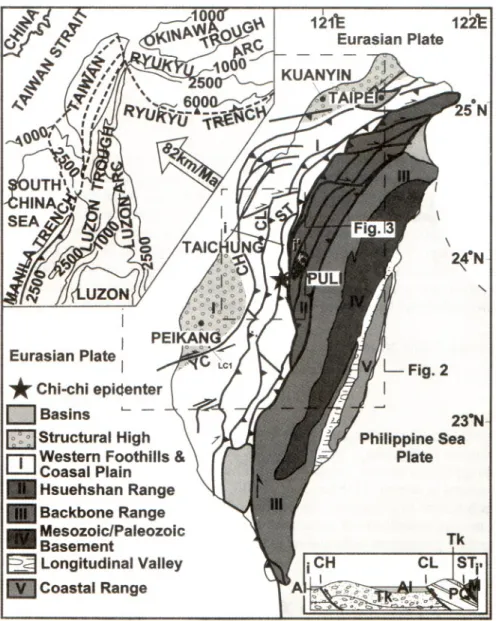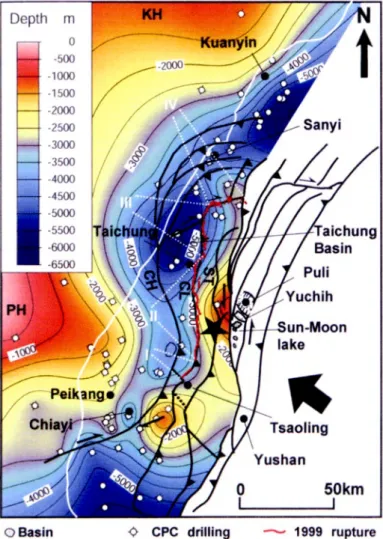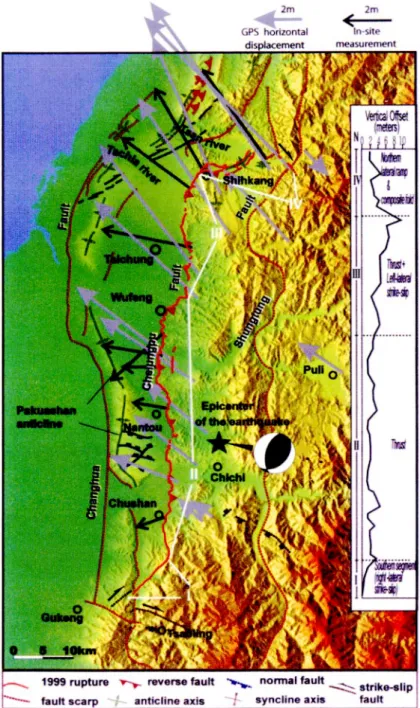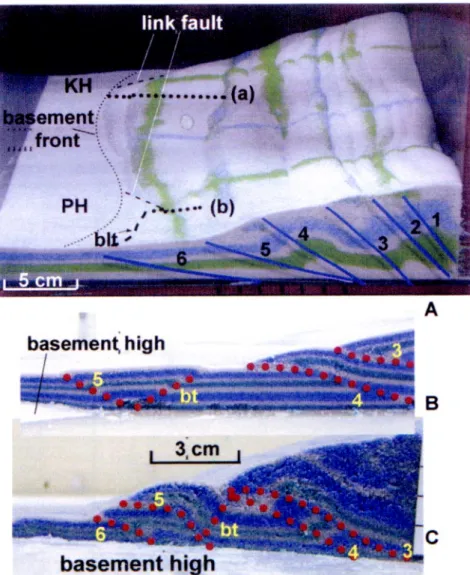181
Vol.2, No.2, P.181-190, 4 Figs., May, 2002
THE 1999 CHI-CHI TAIWAN EARTHQUAKE AND BASEMENT
IMPACT THRUST KINEMATICS
CHIA-YU LU1, HAO-TSU CHU2, JIAN-CHENG LEE3, YU-CHANG CHAN3, KUO-JIAN CHANG4AND FREDERIC MOUTHEREAU5 1. Department of Geosciences, National Taiwan University, Taipei, Taiwan
2. Central Geological Survey, Taipei, Taiwan 3. Institute of Earth Sciences, Academia Sinica, Taipei, Taiwan 4. Lab. Geophysics et Tectoniques, Universite Montpellier II, France 5. Departement de Geotectonique, Universite Pierre et Marie, Curie, Paris, France
ABSTRACT
Tectonism associated with the 1999 Chi-Chi Taiwan earthquake indicates that the shape of the basement controls the resulting foreland fold-and-thrust structures. Results of field observations and sandbox experiments demonstrate that: (1) back thrusts and out-of-sequence thrusts may develop when a thrust wedge approaches a basement high, (2) displacement change along the Chelungpu fault may reflect the interference between fault geometry and basement topography. The high recurrent possibility of the out-of-sequence thrust is also stressed.
Key words: Chi-Chi earthquake, impact thrust kinematics
INTRODUCTION
The 1999 Chi-Chi earthquake (Mw 7.6) was the largest earthquake that occurred in Taiwan during the 20th century. The main shock as well as numerous aftershocks were located on the Chelungpu fault system which generated one of the most active and best-recorded on-land thrust scarps in the world (Shin et al., 2000; Yang et al., 2000). Analysis of these data indicates an intimate link between the pattern of thrusting and basement topography. This paper is an attempt to understand the seismo-tectonic setting of this earthquake-prone region, by analyzing fault geometries and sandbox modelings in order to lay the foundation for the long-term mitigation of seismic hazards.
TECTONIC SETTING: THE TAIWAN MOUNTAIN BELT
The Taiwan Mountain Belt is an active curved collision belt that defines a thrust wedge (e.g. Angelier, 1986; Biq, 1972; Chai, 1972; Lu & Hsu, 1992; Suppe, 1981; Teng, 1990), resulting from the late Cenozoic oblique convergence between the Eurasian and the Philippine Sea
182
Western Pacific Earth Sciences, Vol.2, No.2
plates (Figure 1, modified from Biq, 1997). In west central Taiwan, three important Quaternary faults occur trending approximately N-S and dipping gently towards the east. From east to west, they are the Shuangtung (ST) fault, the Chelungpu (CL) fault (Chang, 1971 a) and the Changhua (CH) fault (Fig.1). The east dipping Shuangtung thrust rides over the Quaternary Toukoshan Formation (Tk) and the Chelungpu thrust over the younger alluvium deposits (Al) of the Taichung basin. The Changhua fault, the frontal thrust, is partially covered by recent alluvium deposits. The reactivation of the Chelungpu thrust rather than the frontal thrust (CH) during the 1999 Chi-Chi earthquake indicates that out-of-sequence thrusting is occurring.
Figure 1. Geological divisions of Taiwan. The upper left inset: geodynamic setting of Taiwan. The lower right inset: schematic cross section along line i-i' across Taichung basin. ST: Shungtung fault, CL: Chelungpu fault, CH: Changhua fault, Tk: Toukoshan Formation. Al: alluvium Deposit. M: Miocene rocks. PQ: Pre-Quaternary rocks.
BASEMENT HIGHS
Buried beneath the multi-kilometers-thick sediment mass of western Taiwan is a complex composed principally of pre-Tertiary igneous and metamorphic rocks. The shallow part of this hard-rock floor forms two sizable basement highs, called the Peikang Basement High and Kuanyin Basement High (Figures 1 and 2;Chang, 1971b; Hsiao, 1967; Huang and Lee, 1962; Lee et al., 1973; Schreiber, 1965; Tang, 1964; Wang, 1965; Wang, 1967). The Peikang Basement High (Hsilo Massif in Biq, 1990) extends from western Taiwan to the Penghu Islands as shown in Figure 1. Results of studies on seismic reflection (Stach, 1958), gravity (Hsieh and Hu, 1972; Lee et al., 1973) and drilling observation (Matumoto, 1965; Chiu, 1973; 1975), indicate that the Neogene strata are underlain by a pre-Miocene basement high (Tang, 1977). The drilling data and the leading edge of the frontal thrust sketch out the semi-circular shape of this basement high. The evidence that the Neogene sediments thicken from about 1500 m thick near Peikang to more than 5000 m thick only 30 km further east indicates the Peikang Basement High extends only a short distance eastward beneath the front belt of west-central Taiwan.
Figure 2. Neotectonics around the Chelungpu fault (CL). Numbers (given in meter) show the depth of the top of the Paleogene/Cre-taceous strata from the surface based on CPC (Chinese Petroleum Com-pany) drilling records (Chang, 1971b; Chiu, 1973; Chou, 1973). Isobaths of the top of Paleogene/Cre-taceous strata is modified from Mouthereau et al., (2000). The large black ar-row marks the plate con-vergent direction. The thrust spacing decreases around Sanyi area; this can be caused by the oblique p r o p a g a t i o n o f t h r u s t toward the Kuanyin High (KH). Note that the epi-center of Chi-Chi earth-quake main shock is located close to the youngest pull-apart basin. See Figure 1 for abbreviations.
184
Western Pacific Earth Sciences, Vol.2, No.2
The neotectonics map of the study area was compiled from Ho, 1978; Biq, 1997 and the Working Group on Chi-Chi Earthquake, 2000 (Fig.2). Based on the drill data from CPC, the isobaths of the depth from the surface to the top of Paleogene/Cretaceous strata (after Mouthereau et al., 2001), the S shape of the thrust front can be clearly shown. The thrust fronts are more advanced to the west while the sediment cover is thicker. For example, in the Taichung area the thrust fronts of the Changhua Fault (CH), and the Chelungpu Fault (CL) are convex to the northwest where the isobaths show basin structure (Fig.2). Several cross-sections across these fault lines were summarized in Lu et al., (2001).
The structure of Peikang Basement High is constrained by large normal faults (Yang et
al., 1991). Seismic surveys showed major blocks separated by a N65oE trending normal fault zone that had been interpreted as a hinge fault (Stach, 1957), i.e. a rapid transition from a shelf (to the north) to a deep basin (to the south). As shown in the seismic structure-contour map of the Orbitoid limestone (Elishewitz, 1963), the strata dip gently to the northeast with little structural disturbance at the north of this Peikang faults zone, whereas south of it the strata dip to the SSE and are cut by several antithetic faults before reaching the Yichu hinge-line fault zone that was regarded as the southern marginal fault of the Peikang Basement High (Fig.1). In the south of the Yichu fault zone, the Mesozoic basement is greatly down-faulted as evidenced by the discovery of a well (LC-1) by the CPC (Chinese Petroleum Company) at a depth of 2600 m, which was still embedded in Miocene strata (Sun, 1965; Meng, 1967; Chou, 1973; Huang, 1978; Hu, et al., 1997).
The earthquakes epicentred in the inner part of this thrust-rimmed semicircle are apparently fewer than those epicentred in the peripheral zone and in the areas immediately on the other side of the boundary thrust (Shin and Chang, 1992). This significant map-pattern shows clearly that the pre-Tertiary Peikang Basement High is underlying the coastal plain and is distinguished by its steadfastness in a mobile belt. Such a crustal mass of great rigidity is very likely to play an important part in determining the superficial strain pattern high above (Biq, 1990).
The Kuanyin Basement High is a protruding part of the Fukien- Reinan Massif (Sun, 1982). The regular westward up-dip thinning of the subsurface strata on the shelf and the core of the Kuanyin massif has been delineated by seismic profiles (Sun, 1982; Tang, 1964). These reflection profiles indicate that the bottom strata of the Kuanyin shelf and Taiwan Strait are undisturbed flat late-Tertiary-to-Quaternary sediments, about 4 km thick, overlying a Mesozoic basement (Wang, 1965).
The notable feature of the Taiwan Mountain Belt is the S shaped geometry of the structural trends (Lu, 1994). The Kuanyin High (KH) and the Peikang High (PH) (Figs.1 and 2) appear to act as rigid barriers. The shape of the basement topography fits well with the shape of the mountain front of western Taiwan and this has led to the suggestion that the basement topography may have a significant influence on the recent tectonism in Taiwan (e.g. Biq, 1990; Chang, 1971b; Chiu, 1973; Chou, 1973; Lu, 1994; Mouthereau et al., 2001).
PREVIOUS EXPERIMENTS ON THE KINEMATIC DEVELOPMENT OF THE WESTERN TAIWAN THRUST WEDGE
Lu et al., (1998) performed a series of sandbox experiments to simulate the kinematics development of the western Taiwan thrust wedge, which took into account the topography of the basement. These experiments showed that:1) at the beginning of compression a curved thrust wedge built up. As the thrust front approached the basement highs that were situated beneath the sand layers, they advanced more rapidly in the region between the two basement
Lu et al.: The Chi-Chi Earthquake and Basement Impact Thrust
blocks. 2) During subsequent compression a new 'north-south' trending thrust segment occurs abnormally between the two basement highs. 3) As deformation continued in this segment, the segments to the north and south fell behind along 'north-south' trending strike (i.e. situated further to the 'east') as a result of the existence of two basement blocks. The structural discontinuities between the central segment and those to the north and south were subsequently linked by strike-slip faults that acted as lateral ramps. These link faults or transfer zones are clearly observed in the field area (Fig. 3) and in related new experiments (Fig. 4A).
Figure 3. Structures around the Chelungpu fault. DTM (Digital Terrain Model, data acquired from Center for Space and Remote Sensing Research, National Central University, T a i w a n ) s h a d e d topography base map s h o w i n g t h a t t h e Chelungpu fault scarp is the sharp contact between the western foreland basins and the eastern inner foothills belt (modified after Chen
et al., 2001). Fault traces
and axes of anticline/ syncline modified after Ho, 1988. 1999 rupture after Working Group on Chi-Chi earthquake. 2000.
Western Pacific Earth Sciences, Vol.2, No.2
186
The experiments indicate that the effect of the basement highs is to reduce the spacing between the thrusts within the thrust wedge and to cause compaction and locking up of the faults almost as soon as the thrusts are formed. This process may be a natural explanation of the out-of-sequence faults reported by Kao & Chen (2000).
Figure 4 A. Sand box experiments illustrating the development of thrust sequence, 1 to 6 from the oldest to the youngest, in the thrust wedge during plate convergence. The blind thrust (blt) occurs in the southeastern part of Peikang basement high. B. Thrust sequence, 3 to 6, from the oldest to the youngest. The backthrust (bt) developed in front of a basement high. C. Out-of-sequence fault formed by the reactivation of fault 3.
187
INSIGHTS FROM THE CHI-CHI EARTHQUAKE SEQUENCE AND NEW EXPERIMENTS
Both the horizontal and vertical displacements of the upper compartment of the Chelungpu fault as well as the focal mechanism of the Chi-Chi earthquake demonstrate clearly the thrusting characteristics. The 1999 rupture of Chelungpu fault can be divided into four (or more than four) discrete fault segments (Fig. 3) according to different magnitudes of slip and structural styles (Ma et al., 2000; Chen et al., 2001; Lin et al., 2001; Robin et al., 2001; Wang et al., 2001). In this paper we adopt the classification of Chen et al (2001). These segments exhibit an extended S shape and generally show a right-step en echelon form which fits the isobaths of the pre-Tertiary basement of western Taiwan (e.g. in comparison with the -3000m isobaths in Figure 3, this contour is a more regional and far-field response of the basement boundary). The southern segment (segment I, about 12 km in rupture length, Figures 2 and 3) consists of dextral strike and reverse faulting that strikes sub-parallel to N40-45o especially when compared with the trace of -3000m isobaths, to the mid-south border of the Peikang High. Vertical offset averages about 0.5 to 2m and dextral slip about 1 to 2m. To the north, the surface trace of segment II strikes north-south, about 38km in rupture length with vertical offsets averaging 3m along the principal trace of the fault which runs sub-parallel to the northern border of the Peikang High. Further to the north, segment III, about 18km long with an average vertical offset of 5m and locally as high as 6m, is situated right in front (to the east) of the Taichung Basin and strikes north-south, sub-parallel to the basement border between the two basement highs. The deformation zone of segment IV consists of a 15km long belt of compressional structures such as anticlines, synclines, monoclines, and thrust. The thrust faults and fold axial surfaces strike between east-west and N50o, which are sub-parallel to the southern border of the Kuanyin High. Vertical offsets are as high as 10m. Pop-up structures are well developed along the Tachia and Taan rivers and the majority of structural evidence in this area strongly suggests that thrusts were associated with a minor component of right-lateral simple shear deformation. The segments I and IV may serve as right-lateral link faults mentioned above and play a transitional role between north-south trending main segments of the Chelungpu fault.
In order to have a better understanding of the evolution of the blind thrust to the south of Chiayi (Fig. 2) and the out-of-sequence faults in front of the basement highs, new experiments have been performed since the 1999 Chi-Chi earthquake. As noted above, results of these experiments, such as that shown in Figuer 4A, show the in-sequence development of thrusts during the generation of a foreland thrust. In addition, by building into the basement blocks, thrust geometries and spacing similar to those found in the mountain fronts of Taiwan were generated. The spacing of thrusts decreases as thrusts approach basement blocks and which has been confirmed in the field as well as by experiments. That is, the spacing between the Shuangtung, Chelungpu and Changhua faults, is larger in the northern part (segment A in Figure 4A) than that in the southern part (segment B).
Additional experiments with a larger sandbox produced a similar sequence of thrust development. However, close to the basement highs, a back-thrust developed as a result of stress accumulation. A pop-up structure, defined by the thrust and back thrust, was formed together with an adjacent basin (Fig. 4B). With continued contractional deformation, the pop-up structure was further pop-uplifted and gradually closed. the basin Stress concentration in this area led to the reactivation of an earlier thrust, (e.g. fault 3 in Figure 4C) i.e., to out-of-sequence
188
Western Pacific Earth Sciences, Vol.2, No.2
thrusting. These structures are clearly shown by seismicity and focal mechanisms on a cross-section of the Chelungpu fault (Kao and Chen, 2000). The out-of-sequence thrust, fault 3 in Figure 4C, ruptured the surface along almost the same fault scarp as fault 4. This implies that, very probably, this scarp will be ruptured again in the near future when the accumulating stress is large enough. The general public and the local government have largely ignored this warning; in most cases they rebuild the constructions at the same place along the Chelungpu fault scarp after the earthquake.
Figure 2 summarizes the tectonics around the Chelungpu fault. The intervening region consists mainly of a series of pull-apart basins, i.e. the Puli, the Yuchih, the Sun-Moon lake basins and two other small unnamed basins in the south. These are the results of the component of strike-slip movement along the thrusts caused by the oblique convergence of the two plates. The largest post-seismic creep recorded (~12 cm in three months) (Yu et al., 2000) and the subsidence in this area (Yu et al., 2001) supports the idea that basin formation is propagating to the south. Since the epicenter of the Chi-Chi earthquake (the black star, Figure 2) is exactly in front of the new basin, it is speculated that the formation of these pull-apart basins is directly linked to the paleo-earthquakes in Central Taiwan.
ACKNOWLEDGMENTS
This work was supported by the National Science Council of Taiwan (NSC 89-2116-M002-016). The first author thanks Jeng, Fu-Su, for providing the experimental equipment, and Chen, Jian-Hua and Chang, Jia-Rong, for helping with the setup of experiments, and. Lo, Ching-Hua, J. Cosgrove, K.O. Thompson, Yui, Tzen-Fu, Teng, Mao-Ching-Hua, Jacob Chu and two anonymous reviewers for revising the manuscript.
REFERENCES
Angelier, J. (1986) Geodynamics of Eurasia-Philippine Sea Plate boundary: Preface: Tectonophysics, 125, IX-X.
Biq, C. (1972) Duel-trench structure in the Taiwan-Luzon region: Proc. Geol. Soc. China, 15, 65-75. Biq, C. (1990) Another Coastal Range on Taiwan: Ti-Chih, 12, 1-14.
Biq, C. (1997) Taiwan. In: Encyclopedia of European and Asian Regional Geology (edited by Moores, E. M. & Fairbridge, R. W.). Chapman and Hills, New York, 711-717.
Chai, B. H. T. (1972) Structural and tectonic evolution of Taiwan: Am. J. Sci., 272, 389-422.
Chang, S. S. L. (1971a) Subsurface geologic study of the Taichung basin: Pet. Geol. Taiwan, 8, 21-45. Chang, S. S. L. (1971b) Subsurface geologic study of the area from the Taipei basin to the Kuanyin Shelf,
Taoyuan, Taiwan: Pet. Geol. Taiwan, 9, 123-144.
Chen, Y. K., Chen, W. S., Lee, J. C., Lee, Y. H., Lee, C. T., Chang, H. C. and Lo, C. H. (2001) Surface rupture of 1999 Chi-Chi earthquake yields insights on active tectonics of Central Taiwan: Bull. Seis. Soc.
Am.,91, 977-985.
Chiu, H. T. (1973) Basement rocks under the Neogene formations of west-central Taiwan: Proc. Geol.
Soc. China, 16, 51-58.
Chiu, H.T. (1975) Miocene stratigraphy and its relation to the Paleogene rocks in the west-central Taiwan:
Lu et al.: The Chi-Chi Earthquake and Basement Impact Thrust
Chou, J. T. (1973) Sedimentology and paleogeography of the Upper Cenozoic system of western Taiwan:
Proc. Geol. Soc. China, 16, 111-144.
Ho, C.S. (1978) Tectonic map of Taiwan, 1:500,000: Ministry of Economic Affairs, R.O.C.,
Hsiao, P.T. (1967) Seismic study of the Taoyuan tableland, Taiwan: Petrol. Geol. Taiwan, 5, 63-79. Hsieh, S.H. and Hu, C.C. (1972) Gravimetric and magnetic studies of Taiwan: Pet. Geol. Taiwan, 10,
283-321.
Huang, T.C. (1978) Calcareous nannofossils of the subsurface pre-Miocene rocks from the Peikang basement high and adjacent areas in western central Taiwan (Part I; Cretaceous): Petroleum Geology
of Taiwan, 15, 49-87.
Huang, T. and Lee, P.J. (1962) Stratigraphy of the Kuanyin well, Taoyuan, and its relation to that of the Peikang well, Yunlin, Taiwan: Petrol. Geol. Taiwan, 67-74.
Kao, H. and Chen, W. P. (2000) The Chi-Chi Earthquake Sequence: Active, Out-of-Sequence Thrust Faulting in Taiwan: Science, 288, 2346-2349.
Lee, C.S., Shyu, C.T. and Leu, F.J. (1973) Structure of the eastern Taiwan Strait: Acta Oceanogr. Taiwan. (Natl. Taiwan Univ., Inst. Oceanogr.), 3, 117-139.
Lee, J. C., Chu, H. T., Angelier, J., Chan, Y. C., Hu, J. C., Lu, C. Y. and Rau, R. J. (2002) Geometry and structure of northern surface ruptures of the 1999 Mw=7.6 Chi-Chi, Taiwan earthquake: Influence from inherited fold belt structures: Jour. Struct. Geology, 24, 173-192.
Lin, A., Ouchi, T., Chen, A. and Maruyama, T. (2001) Co-seismic displacements, folding and shortening structures along the Chelungpu surface rupture zone occurres during the 1999 Chi-Chi (Taiwan) earthquake: Tectonophysics, 330, 225-244.
Lu, C. Y. (1994) Neotectonics in the foreland thrust belt of Taiwan: Petrol. Geol. Taiwan, 29, 1-26. Lu, C. Y., Chang, K. J., Jeng, F. S. and Jian, W. T. (1998) Impact of basement high on the structure and
kinematics of the western Taiwan thrust wedge: insights from sandbox models: TAO, 9, 533-550. Lu, C. Y. and Hsu, K. J. (1992) Tectonic evolution of the Taiwan Mountain Belt: Petrol. Geol. Taiwan, 27
(27), 21-46.
Lu, C.Y., Chan, Y.C., Wu, J.C., Chu, H.T. and Lee, J.C. (2001) Indentation tectonics around the Peikang Basement High and the oil migration in Taiwan: A working hypothesis: Global Chinese Petroleum
and Petrochemical Technology Symposium, (47),1-26.
Ma, K.F., Song, T. R., Lee, S. J. and Wu, H. I. (2000) Spatial slip distribution of the September 20, 1999, Chi-Chi, Taiwan earthquake (Mw = 7.6 - inverted from Teleseismic data: Geophys. Res. Lett., 27, 3417-3420.
Matsumoto, R. (1965) Some molluscan fissils from the buried Cretaceous of western Taiwan: Pet. Geol.
Taiwan, 4, 1-24.
Meng, C. Y. (1967) The structural development of the southern half of western Taiwan: Proc. Geol. Soc.
China, 10, 77-82.
Mouthereau, F., Deffontaines, B., Lacombe, O. and Angelier, J. (2001) Along-strike variations of the Taiwan belt front: basement control on structural style, wedge geometry and kinematics: GSA Special
Publication. (in press)
Rubin, C. M., Sieh, K., Chen, Y. K., Lee, J. C., Chu, H. T., Yeats, R., Mueller, K. and Chan, Y. C. (2001) Surface rupture and behavior of thrust faults probed in Taiwan: EOS, 82(47), 565-569.
Schreiber, A. (1965) On the geology of the Cenozoic geosyncline in middle and northern Taiwan (China) and its petroleum potentialities: Petrol. Geol. Taiwan, 4, 25-87.
190
Western Pacific Earth Sciences, Vol.2, No.2
Shin, T. and Chang, Z. (1992) Earthquakes in 1992: Proceeding of Meteorology, 38, 218-232.
Shin, T. C., Kuo, K. W., Lee, W. H. K., Teng, T. L. and Tsai, Y. B. (2000). A preliminary report on the 1999 Chi-Chi (Taiwan) earthquake: Seismo. Res. Let., 71, 24-29.
Stach, L.W. (1957) Stratigraphic subdivision and correlation of the upper Cenozoic sequence in the Foothills region of Chiayi and Hsinying, Taiwan: Symp. Petroleum Geology of Taiwan, Chinese Petroleum Corporation, Taipei, 1, 179-230.
Stach, L.W. (1958) Subsurface exploration and geology of the coastal plain region of western Taiwan:
Proc. Geol. Soc. China, 1, 55-96.
Sun, S.C. (1965) Geology and petroleum potentialities of the Chingshui-Yuanlin area, Taiwan: Petrol.
Geol. Taiwan, 161-173.
Sun, S.C. (1982) The Tertiary basins of offshore Taiwan: 2nd ASEAN Council on Petroleum (ASCOPE)
Conference, Manila (1981) Proc., 125-135.
Suppe, J. (1981) Mechanics of mountain building in Taiwan: Memo. Geol. Soc. China, 4, 67-89. Tang, C.H. (1964) Subsurface geology and oil possibilities of the Taoyuan district: Petrol. Geol. Taiwan,
53-73.
Tang, C.H. (1977) Late Miocene erosional unconformity on the subsurface of Peikang high beneath the Chiayi-Yunlin coastal plain Taiwan: Memoir Geol. Soc. China, 2, 155-167.
Teng, L.S. (1990) Geotectonic evolution of late Cenozoic arc-continent collision in Taiwan: Tectonophysics,
183, 57-77.
Wang, P.C.M. (1965) Reflection profiles off the shore at Kuanyin, Taiwan: Petrol. Geol. Taiwan, 4, 303-306.
Wang, P.C.M. (1967) Subsurface geology and oil possibilities of the Taoyuan-Miaoli offshore region Taiwan: Petrol. Geol. Taiwan, 5, 81-98.
Wang, W. H.,Chang, S. H. and Chen, C. H. (2001) Fault slip invert from surface displacements during the 1999 Chi-Chi Taiwan earthquake: Bull. Seis. Soc. Am.,91, 1167-1181.
Working Group on Chi-Chi earthquake. (2000) Geological ruptures along the Chelungpu fault during the Chi-Chi earthquake: Central Geological Survey of Taiwan (MOEACGS), 4 map sheets.
Yang, K.M., Ting, H.H. and Yuan, J.W. (1991) Structural styles and tectonic modes of Neogene extensional tectonics in southwestern Taiwan: implications for hydrocarbon exploration: Petrol. Geol. Taiwan,
26, 1-31.
Yang, M., Rau, R. J., Yu, J. Y. and Yu, T. T. (2000) Geodetically observed surface displacements of the 1999 Chi-Chi, Taiwan earthquake: Earth Planets Space , 52, 403-413.
Yu, S. B., Kuo, L. C., Hsu, Y. J., Liu, C. C., Su, H. H., Hou, C. S., Lee, J. F. and Lai, T. C. (2000) Coseismic and postseismic deformation associated with the 1999 Chi-Chi, Taiwan earthquake: EOS, Transactions,
American Geophysical Union, supplement, 81(22), WP-116.
Yu, S. B., Kuo, L. C., Hsu, Y. J., Su, H. H., Liu, C. C., Hou, C. S., Lee, J. F., Lai, T. C., Liu, C. L., Tseng, T. F., Tsai, C. S. and Shin, T. C. (2001) Preseismic and coseismic displacement associated with the 1999 Chi-Chi, Taiwan earthquake: Bull. Seis. Soc. Am., 91, 995-1012.



